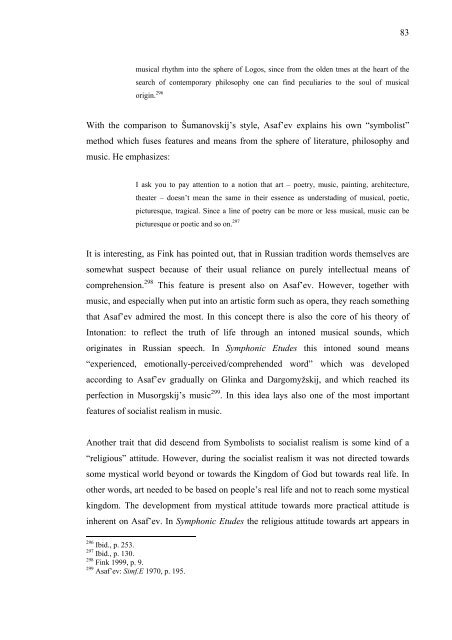Boris Asaf'ev and the Soviet Musicology - E-thesis
Boris Asaf'ev and the Soviet Musicology - E-thesis
Boris Asaf'ev and the Soviet Musicology - E-thesis
You also want an ePaper? Increase the reach of your titles
YUMPU automatically turns print PDFs into web optimized ePapers that Google loves.
musical rhythm into <strong>the</strong> sphere of Logos, since from <strong>the</strong> olden tmes at <strong>the</strong> heart of <strong>the</strong><br />
search of contemporary philosophy one can find peculiaries to <strong>the</strong> soul of musical<br />
origin. 296<br />
With <strong>the</strong> comparison to Šumanovskij’s style, Asaf’ev explains his own “symbolist”<br />
method which fuses features <strong>and</strong> means from <strong>the</strong> sphere of literature, philosophy <strong>and</strong><br />
music. He emphasizes:<br />
I ask you to pay attention to a notion that art – poetry, music, painting, architecture,<br />
<strong>the</strong>ater – doesn’t mean <strong>the</strong> same in <strong>the</strong>ir essence as understading of musical, poetic,<br />
picturesque, tragical. Since a line of poetry can be more or less musical, music can be<br />
picturesque or poetic <strong>and</strong> so on. 297<br />
It is interesting, as Fink has pointed out, that in Russian tradition words <strong>the</strong>mselves are<br />
somewhat suspect because of <strong>the</strong>ir usual reliance on purely intellectual means of<br />
comprehension. 298 This feature is present also on Asaf’ev. However, toge<strong>the</strong>r with<br />
music, <strong>and</strong> especially when put into an artistic form such as opera, <strong>the</strong>y reach something<br />
that Asaf’ev admired <strong>the</strong> most. In this concept <strong>the</strong>re is also <strong>the</strong> core of his <strong>the</strong>ory of<br />
Intonation: to reflect <strong>the</strong> truth of life through an intoned musical sounds, which<br />
originates in Russian speech. In Symphonic Etudes this intoned sound means<br />
“experienced, emotionally-perceived/comprehended word” which was developed<br />
according to Asaf’ev gradually on Glinka <strong>and</strong> Dargomyžskij, <strong>and</strong> which reached its<br />
perfection in Musorgskij’s music 299 . In this idea lays also one of <strong>the</strong> most important<br />
features of socialist realism in music.<br />
Ano<strong>the</strong>r trait that did descend from Symbolists to socialist realism is some kind of a<br />
“religious” attitude. However, during <strong>the</strong> socialist realism it was not directed towards<br />
some mystical world beyond or towards <strong>the</strong> Kingdom of God but towards real life. In<br />
o<strong>the</strong>r words, art needed to be based on people’s real life <strong>and</strong> not to reach some mystical<br />
kingdom. The development from mystical attitude towards more practical attitude is<br />
inherent on Asaf’ev. In Symphonic Etudes <strong>the</strong> religious attitude towards art appears in<br />
296 Ibid., p. 253.<br />
297 Ibid., p. 130.<br />
298 Fink 1999, p. 9.<br />
299 Asaf’ev: Simf.E 1970, p. 195.<br />
83

















